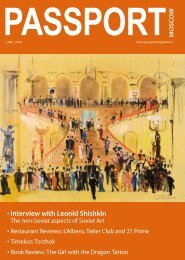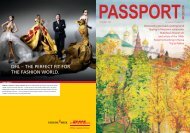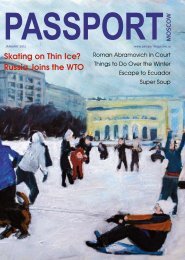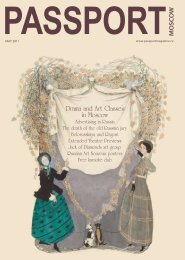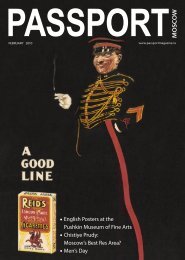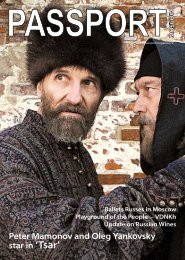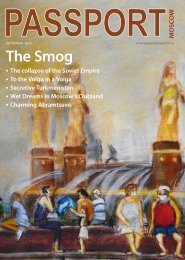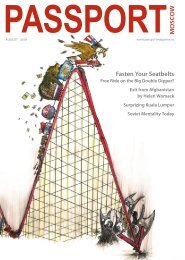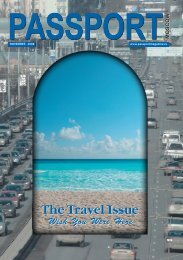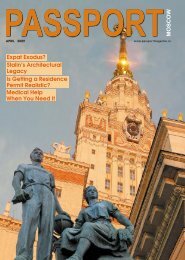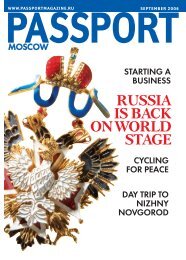Post-Perestroika Warrior - Passport magazine
Post-Perestroika Warrior - Passport magazine
Post-Perestroika Warrior - Passport magazine
You also want an ePaper? Increase the reach of your titles
YUMPU automatically turns print PDFs into web optimized ePapers that Google loves.
Art History<br />
Yevgeny Oks:<br />
Artist<br />
Rediscovered<br />
text by Olga Slobodkina-von Brømssen<br />
It’s always thrilling to write about a forgotten artist. This time<br />
it is Yevgeny Oks (1899-1968). It’s hard to say why the Soviet art<br />
world failed to recognize such an interesting art personality<br />
– maybe because he followed the then much frowned upon<br />
impressionistic traditions or for some other political rather than<br />
artistic reasons. Whatever the reason, from the beginning of<br />
the 1930s, Oks was never included in the list of exhibited artists<br />
and was rediscovered only in the 1990s when the art heritage<br />
of the 1920s-1950s was first staged in Moscow bringing to light<br />
many of the suppressed names of the 20th century in Russia.<br />
The creative life of Yevgeny Oks began during the complicated,<br />
revolutionary period of 1917-1918. Born in St. Petersburg<br />
in 1899, he was a student of the New Art Workshop<br />
created by Princess Gagarina on Vasilyevsky Island<br />
until 1917. During his studies at the New Art Workshop,<br />
Oks was tutored by such famous artists as Alexander Yakovlev,<br />
Vasily Shukhaev, Osip Braz and Mstislav Dobyzhinsky.<br />
The teachers at the workshop were primarily from the<br />
World of Art, a group of artists (1896-1924) whose aesthetic<br />
foundation was the idea of a synthesis of arts and a special<br />
kind of retrospectivism, which looked towards antiquity<br />
and diverse historical and cultural reminiscences.<br />
In 1918, Oks moved to Odessa to continue his art studies<br />
at the Odessa Art School, as the October Revolution of<br />
1917 had prevented him from returning home. In Odessa,<br />
the artist also participated in the creation of the Poet’s<br />
Club. The club boasted such famous literary names as Eduard<br />
Bagritsky, Yuri Olesha, Ilya Ilf and Zinaida Shishova.<br />
The club’s heady cultural environment influenced the formation<br />
of Yevgeny Oks’s personal creativity and the artist<br />
wrote several poems and memoirs about that epoch.<br />
Oks was a military artist in the town of Kronshtadt, then<br />
he moved on to Moscow where his professional and creative<br />
life began. We know that he participated in an exhi-<br />
1 September 2009<br />
bition of the NOZH group of artists in 1923. NOZH is an acronym<br />
for the New Society of Artists. Its manifesto declared the<br />
end of “the analytical period” in the arts and characterized<br />
realism not as “a faceless protocol portrayal of life, but as a<br />
creative reassessment of life and a deep personal attitude<br />
towards it”. Some of his works have survived since that time:<br />
his self-portraits, a classical portrait of his wife dating back to<br />
1923 as well as some city landscapes and still-lifes.<br />
At the same time Oks was elected to The Council of Art<br />
Schools and participated in the reorganization of the Academy<br />
of Arts. He also worked for the newspaper Zor whose<br />
editor was Osip Brik.<br />
From 1922, Yevgeny Oks lived in Moscow where he concentrated<br />
on drawing: he was a commissioned drawer for<br />
many <strong>magazine</strong>s and newspapers, including Literaturnaya<br />
Gazeta. His drawings “In the City Garden” and “Ploshchad<br />
Sverdlova” recreated the pre-war atmosphere of Moscow.<br />
A true follower of Vlamink and Cezanne, Yeveny Oks<br />
worked out his own artistic language of coloristic painting,<br />
and created quite a number of works valuable both from<br />
an artistic and social point of view. He used that language<br />
“Construction site”, 1934, (charcoal pencil on paper) “Construction of an Embankment”, 1934, (charcoal on paper)<br />
“Self-Portrait”, 1922, (oil on canvas)



